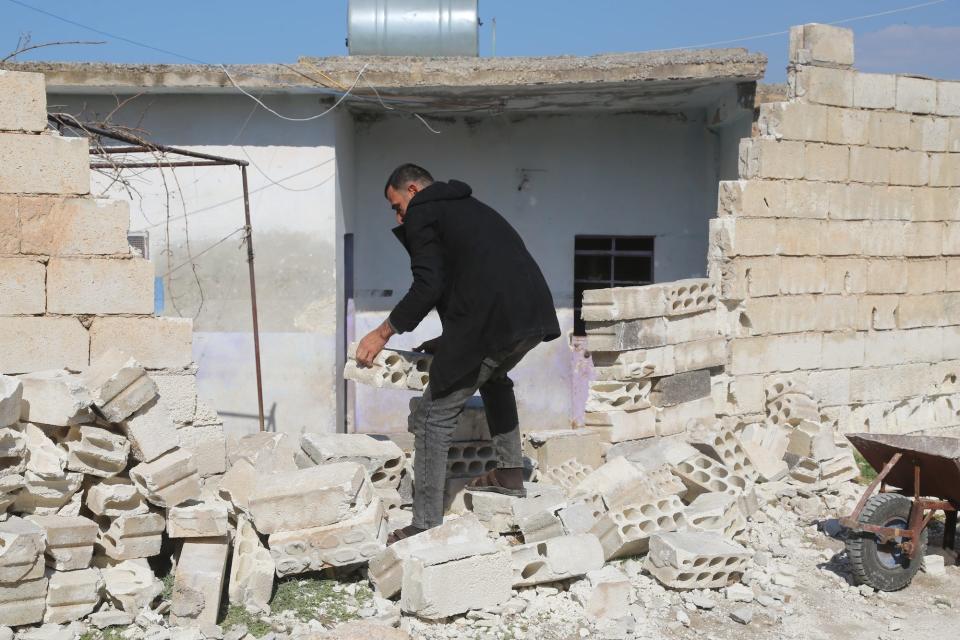Drones have ushered in a brutal new phase of Syria's civil war

Drones are increasingly shaping the warfare in the Syrian civil war.
The most widely drones are explosive-laden quadcopters that can be flown into a target.
"When the status quo finally breaks, it could happen very quickly and dramatically," an expert said.
Drones are increasingly shaping warfare in the Syrian civil war that entered its 14th year in March. Both sides have stepped up drone attacks on each other in recent months, as the attention and resources of the regime's backer, Russia, are focused on Ukraine.
Since the beginning of 2024, forces loyal to President Bashar al-Assad in Damascus reportedly shot down at least 33 drones launched by the Hayat Tahrir al-Sham militant group that controls the northwestern Idlib province. Regime forces have also targeted HTS-controlled territories with at least 48 single-use exploding drones.
The current round of tit-for-tat drone strikes began in October when an unprecedented drone attack killed at least 89 and injured as many as 277 at a Syrian military graduation ceremony in Homs. Damascus responded by striking rebel-held Idlib. It has also increased the targeting of civilians using drones.
"The increasing use of these drones is likely due to their low prices and high accuracy," Freddy Khoueiry, a global security analyst for the Middle East and North Africa at the risk intelligence company RANE, told Business Insider. "They can hover over their targets before striking, making hits more accurate."
The most widely used type in Syria are first-person view drones, typically quadrotors that cost less than $1,000 and are remotely piloted into a target via a video feed. While small compared to more advanced drones like the infamous Iranian-built Shahed-136 loitering munition Russia has used against Ukraine, these inexpensive drones rigged with explosives are still lethal.
"They're still dangerous, especially in Syria, where both regime and opposition air defenses against these are scarce or ineffective mostly," Khoueiry said.
Aron Lund, a Syria expert and fellow with Century International, noted that there has barely been any movement along the Syrian war's frontlines since spring 2020, a situation he warns won't last forever.
"When the status quo finally breaks, it could happen very quickly and dramatically," Lund told BI. "Despite the geographic stalemate, all sides still fire at each other every now and then. Sometimes, there are serious flare-ups."
Khoueiry summed up the current phase in the war as "a continuation of tit-for-tat exchanges we've seen over the past months and years between regime and opposition forces albeit with an increase in frequency and intensity, in addition to the use of drones."
"The use of drones falls under the global military trend of increasing loitering munitions usage due to their wide availability and ease of operation," Khoueiry said.
Unlike the HTS Islamist militants it is fighting, the Syrian military has other options to strike from a distance, such as artillery and aircraft.

However, unlike drones, Syrian Air Force aircraft require significant support from Russia. Given Russia's embroilment in Ukraine, Lund suspects Moscow's "tolerance for escalation" in Syria has decreased.
"The Russians might not want to spend any more jet fuel and Soviet-designed bombs on Assad just to help him blow up hospitals and marketplaces in Idlib," Lund said. "They now have their own hospitals and marketplaces to blow up in Ukraine."
In addition to being cheap, the regime can manufacture these drones, or at least many of their components, locally.
"The Scientific Studies and Research Center, a Ministry of Defense body that also ran Syria's chemical weapons program, has worked on military drones in the past, as well as on Iranian-assisted missile production," Lund said. "I would be surprised if they're not still doing it."
The Syria expert also pointed out that it would make "a lot of sense for Iran to help set up production lines" inside Syria.
"By supporting local production in Syria, Iran can bypass cumbersome and insecure smuggling routes," Lund said. "It would be a way of supporting both Assad's government and Hezbollah — and perhaps other allies, too."
RANE's Khoueiry noted that many reports have detailed that these drones are locally assembled and built under Iranian and Russian supervision. Furthermore, several Iran-backed groups — including the Houthis in Yemen, Hezbollah in Lebanon, and Iraqi militias — have assembled drones using parts shipped from Iran.
"Given the proliferation of pro-Iran militias in Syria and the Syrian regime's dire economy, it would be logical to assume that they're likely assembling these rather than importing them," Khoueiry said. "HTS could be potentially doing the same, but under Turkish supervision and/or support most likely."
A swarm of drones originating from Idlib targeted Russia's main airbase in Syria, Hmeimim, in the coastal province of Latakia in January 2018.
"It seems well within the means of Tahrir al-Sham, the dominant jihadi militia in Idlib, to manufacture and use kamikaze drones," Lund said. "They might not be the most sophisticated drones around, but I'm sure they can build something good enough to fly to its target and explode unless shot down."
Even though many of these opposition drones are often described as crude, low-tech, and DIY, Lund also does not rule out the possibility that Syrian opposition groups have received state backing for some attacks.
"While there's no real evidence either way, it also seems possible that Syrian rebels have received under-the-table support from their backer, Turkey," Lund said.
"It may even be that Turkey is behind some of these unclaimed drone strikes as part of its own tit-for-tat game with Russia."
Read the original article on Business Insider

 Yahoo News
Yahoo News 
